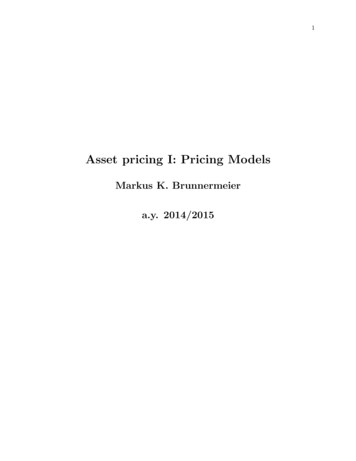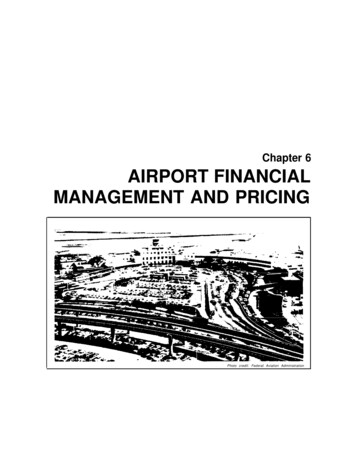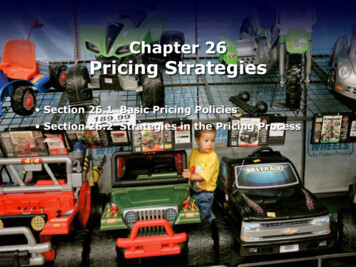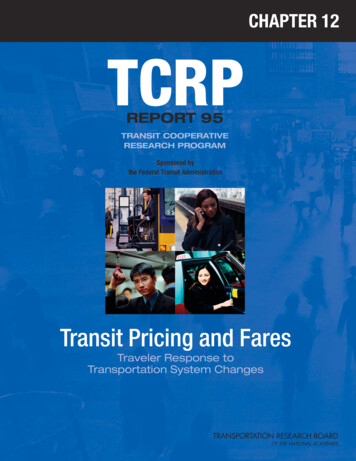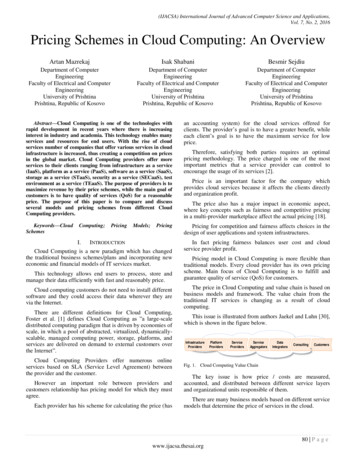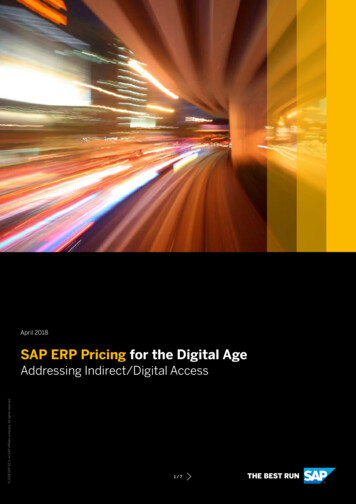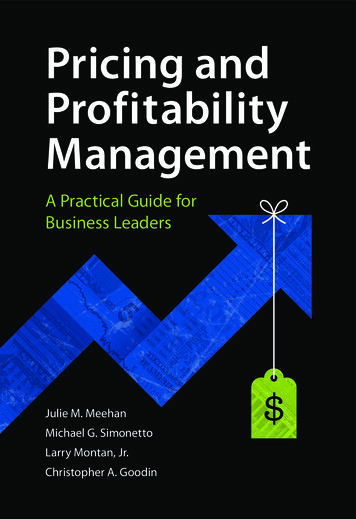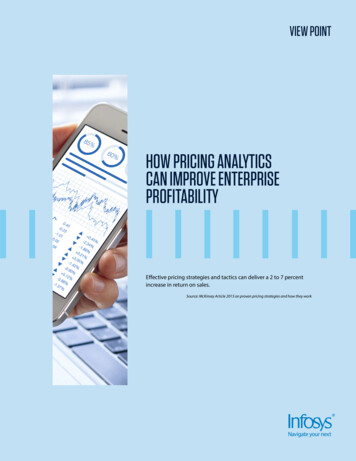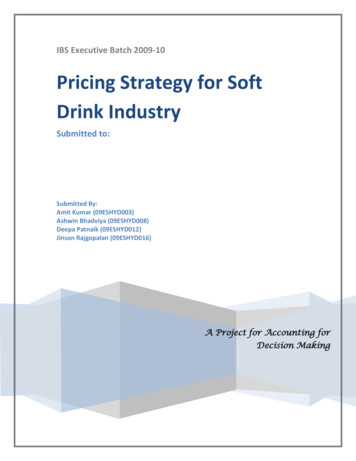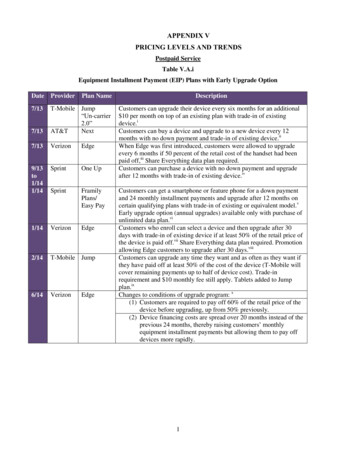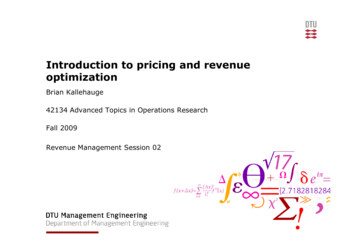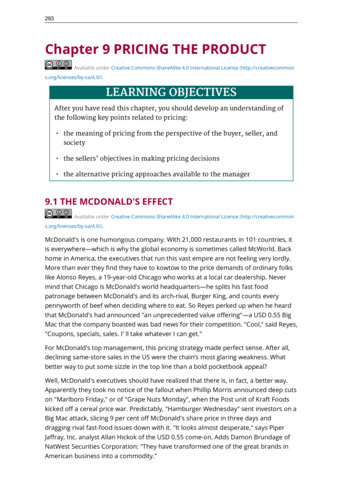
Transcription
293Chapter 9 PRICING THE PRODUCTAvailable under Creative Commons-ShareAlike 4.0 International License EARNING OBJECTIVESAfter you have read this chapter, you should develop an understanding ofthe following key points related to pricing: the meaning of pricing from the perspective of the buyer, seller, andsociety the sellers' objectives in making pricing decisions the alternative pricing approaches available to the manager9.1 THE MCDONALD'S EFFECTAvailable under Creative Commons-ShareAlike 4.0 International License cDonald's is one humongous company. With 21,000 restaurants in 101 countries, itis everywhere—which is why the global economy is sometimes called McWorld. Backhome in America, the executives that run this vast empire are not feeling very lordly.More than ever they find they have to kowtow to the price demands of ordinary folkslike Alonso Reyes, a 19-year-old Chicago who works at a local car dealership. Nevermind that Chicago is McDonald's world headquarters—he splits his fast foodpatronage between McDonald's and its arch-rival, Burger King, and counts everypennyworth of beef when deciding where to eat. So Reyes perked up when he heardthat McDonald's had announced "an unprecedented value offering"—a USD 0.55 BigMac that the company boasted was bad news for their competition. "Cool," said Reyes,"Coupons, specials, sales. I' ll take whatever I can get."For McDonald's top management, this pricing strategy made perfect sense. After all,declining same-store sales in the US were the chain’s most glaring weakness. Whatbetter way to put some sizzle in the top line than a bold pocketbook appeal?Well, McDonald's executives should have realized that there is, in fact, a better way.Apparently they took no notice of the fallout when Phillip Morris announced deep cutson "Marlboro Friday," or of "Grape Nuts Monday", when the Post unit of Kraft Foodskicked off a cereal price war. Predictably, "Hamburger Wednesday" sent investors on aBig Mac attack, slicing 9 per cent off McDonald's share price in three days anddragging rival fast-food issues down with it. "It looks almost desperate," says PiperJaffray, Inc. analyst Allan Hickok of the USD 0.55 come-on. Adds Damon Brundage ofNatWest Securities Corporation: "They have transformed one of the great brands inAmerican business into a commodity."
294In theory, McDonald's plan will payoff, because customers only get the discount if theybuy a drink and french-fries, too. Yet that gimmick-within-a-gimmick threatens toundermine pricier "Extra Value Meals," one of the most successful marketinginitiatives. Consumers expecting cut-rate combos will not go back to paying full price,1especially if other fast-feeders discount their package deals.9.2 INTRODUCTIONAvailable under Creative Commons-ShareAlike 4.0 International License rom a customer's point of view, value is the sole justification for price. Many timescustomers lack an understanding of the cost of materials and other costs that go intothe making of a product. But those customers can understand what that product doesfor them in the way of providing value. It is on this basis that customers makedecisions about the purchase of a product.Effective pricing meets the needs of consumers and facilitates the exchange process.It requires that marketers understand that not all buyers want to pay the same pricefor products, just as they do not all want the same product, the same distributionoutlets, or the same promotional messages. Therefore, in order to effectively priceproducts, markets must distinguish among various market segments. The key toeffective pricing is the same as the key to effective product, distribution, andpromotion strategies. Marketers must understand buyers and price their productsaccording to buyer needs if exchanges are to occur, However, one cannot overlook thefact that the price must be sufficient to support the plans of the organization,including satisfying stockholders. Price charged remains the primary source ofrevenue for most businesses.9.3 PRICE DEFINED: THREE DIFFERENT PERSPECTIVESAvailable under Creative Commons-ShareAlike 4.0 International License lthough making the pricing decision is usually a marketing decision, making itcorrectly requires an understanding of both the customer and society's view of priceas well. In some respects, price setting is the most important decision made by abusiness. A price set too low may result in a deficiency in revenues and the demise ofthe business. A price set too high may result in poor response from customers and,unsurprisingly, the demise of the business. The consequences of a poor pricingdecision, therefore, can be dire. We begin our discussion of pricing by considering theperspective of the customer.1. Sources: Greg Burns, "McDonald's: Now, It's Just Another Burger Joint," Business Week, March 17, 1997, pp. 3-8; BillMcDowell, "McDonald's Falls Back to Price-Cutting Tactics," Advertising Age, 3, 1997, pp. 5-7; Michael Hirsch, ''The Price isRight," Time, February 10, 1997, p. 83; Louise Kramer, "More-Nimble McDonald's is Getting Back on Track," AdvertisingAge, January 18, 1999, p. 6; David Leonhardt, "Getting Off Their McButts," Business Week, February 22, 1999, pp. 84-85;Bruce Horovitz, "Fast-Food Facilities Face Sales Slowdown," USA Today, Wednesday, February 21 , 2001, p. 3B.
2959.3.1 The Customer's View of PriceAvailable under Creative Commons-ShareAlike 4.0 International License s discussed in an earlier chapter, a customer can be either the ultimate user of thefinished product or a business that purchases components of the finished product. Itis the customer that seeks to satisfy a need or set of needs through the purchase of aparticular product or set of products. Consequently, the customer uses several criteriato determine how much they are willing to expend in order to satisfy these needs.Ideally, the customer would like to pay as little as possible to satisfy these needs. Thisperspective is summarized in Figure 9.1.Figure 9.1 The customer's view of priceTherefore, for the business to increase value (i.e. create the competitive advantage), itcan either increase the perceived benefits or reduce the perceived costs. Both of theseelements should be considered elements of price. To a certain extent, perceivedbenefits are the mirror image of perceived costs. For example, paying a premium price(e.g. USD 650 for a piece of Lalique crystal) is compensated for by having this exquisitework of art displayed in one's home. Other possible perceived benefits directly relatedto the price-value equation are status, convenience, the deal, brand, quality, choice,and so forth. Many of these benefits tend to overlap. For instance, a Mercedes BenzE750 is a very high-status brand name and possesses superb quality. This makes itworth the USD 100,000 price tag. Further, if one can negotiate a deal reducing theprice by USD 15,000, that would be his incentive to purchase. Likewise, someone livingin an isolated mountain community is willing to pay substantially more for groceries ata local store rather than drive 78 miles (25.53 kilometers) to the nearest Safeway. Thatperson is also willing to sacrifice choice for greater convenience. Increasing theseperceived benefits is represented by a recently coined term, value-added. Thus,providing value-added elements to the product has become a popular strategicalternative. Computer manufacturers now compete on value-added components suchas free delivery setup, training, a 24-hour help line, trade-in, and upgrades.Perceived costs include the actual dollar amount printed on the product, plus a host ofadditional factors. As noted, these perceived costs are the mirror-opposite of thebenefits. When finding a gas station that is selling its highest grade for USD 0.06 lessper gallon, the customer must consider the 16 mile (25.75 kilometer) drive to getthere, the long line, the fact that the middle grade is not available, and heavy traffic.
296Therefore, inconvenience, limited choice, and poor service are possible perceivedcosts. Other common perceived costs include risk of making a mistake, related costs,lost opportunity, and unexpected consequences, to name but a few. A new cruisetraveler discovers he or she really does not enjoy that venue for several reasons—e.g.he or she is given a bill for incidentals when she leaves the ship, has used up hervacation time and money, and receives unwanted materials from this company foryears to come.In the end, viewing price from the customer's perspective pays off in many ways. Mostnotably, it helps define value—the most important basis for creating a competitiveadvantage.9.3.2 Price from a Societal PerspectiveAvailable under Creative Commons-ShareAlike 4.0 International License rice, at least in dollars and cents, has been the historical view of value. Derived froma bartering system (exchanging goods of equal value), the monetary system of eachsociety provides a more convenient way to purchase goods and accumulate wealth.Price has also become a variable society employs to control its economic health. Pricecan be inclusive or exclusive. In many countries, such as Russia, China, and SouthAfrica, high prices for products such as food, health care, housing, and automobiles,means that most of the population is excluded from purchase. In contrast, countriessuch as Denmark, Germany, and Great Britain charge little for health care andconsequently make it available to all.There are two different ways to look at the role price plays in a society: rational manand irrational man. The former is the primary assumption underlying economictheory, and suggests that the results of price manipulation are predictable. The latterrole for price acknowledges that man's response to price is sometimes unpredictableand pretesting price manipulation is a necessary task. Let us discuss each briefly.9.3.2.1 Rational Man Pricing: An Economic PerspectiveAvailable under Creative Commons-ShareAlike 4.0 International License asically, economics assumes that the consumer is a rational decision maker and hasperfect information. Therefore, if a price for a particular product goes up and thecustomer is aware of all relevant information, demand will be reduced for thatproduct. Should price decline, demand would increase. That is, the quantitydemanded typically rises causing a downward sloping demand curve.A demand curve shows the quantity demanded at various price levels (see Figure 9.2).As a seller changes the price requested to a lower level, the product or service maybecome an attractive use of financial resources to a larger number of buyers, thusexpanding the total market for the item. This total market demand by all buyers for aproduct type (not just for the company's own brand name) is called primary demand.Additionally, a lower price may cause buyers to shift purchases from competitors,
297assuming that the competitors do not meet the lower price. If primary demand doesnot expand and competitors meet the lower price the result will be lower totalrevenue for all sellers.Figure 9.2 Price and demand.Since, in the US, we operate as a free market economy, there are few instances whensomeone outside the organization controls a product's price. Even commodity-likeproducts such as air travel, gasoline, and telecommunications, now determine theirown prices. Because large companies have economists on staff and buy into theassumptions of economic theory as it relates to price, the classic price-demandrelationship dictates the economic health of most societies. The Chairman of the USFederal Reserve determines interest rates charged by banks as well as the moneysupply, thereby directly affecting price (especially of stocks and bonds). He isconsidered by many to be the most influential person in the world.9.3.2.2 Irrational Man Pricing: Freedom RulesAvailable under Creative Commons-ShareAlike 4.0 International License here are simply too many examples to the contrary to believe that the economicassumptions posited under the rational man model are valid. Prices go up and peoplebuy more. Prices go down and people become suspicious and buy less. Sometimes wesimply behave in an irrational manner. Clearly, as noted in our earlier discussion onconsumers, there are other factors operating in the marketplace. The ability of payinga price few other can afford may be irrational, but it provides important personal
298status. There are even people who refuse to buy anything on sale. Or, others who buyeverything on sale. Often businesses are willing to hire a USD 10,000 consultant, whodoes no more than a USD 5,000 consultant, simply to show the world they aresuccessful.In many societies, an additional irrational phenomenon may exist—support of thosethat cannot pay. In the US, there are literally thousands of not-for-profit organizationsthat provide goods and services to individuals for very little cost or free. There are alsogovernment agencies that do even more. Imagine what giving away surplus food tothe needy does to the believers of the economic model.Pricing planners must be aware of both the rational as well as the irrational model,since, at some level, both are likely operating in a society. Choosing one over the otheris neither wise nor necessary.9.3.3 The Marketer's View of PriceAvailable under Creative Commons-ShareAlike 4.0 International License rice is important to marketers, because it represents marketers' assessment of thevalue customers see in the product or service and are willing to pay for a pro
For McDonald's top management, this pricing strategy made perfect sense. After all, declining same-store sales in the US were the chain’s most glaring weakness. What better way to put some sizzle in the top line than a bold pocketbook appeal? Well, McDonald's executives should have realized that there is, in fact, a better way.
